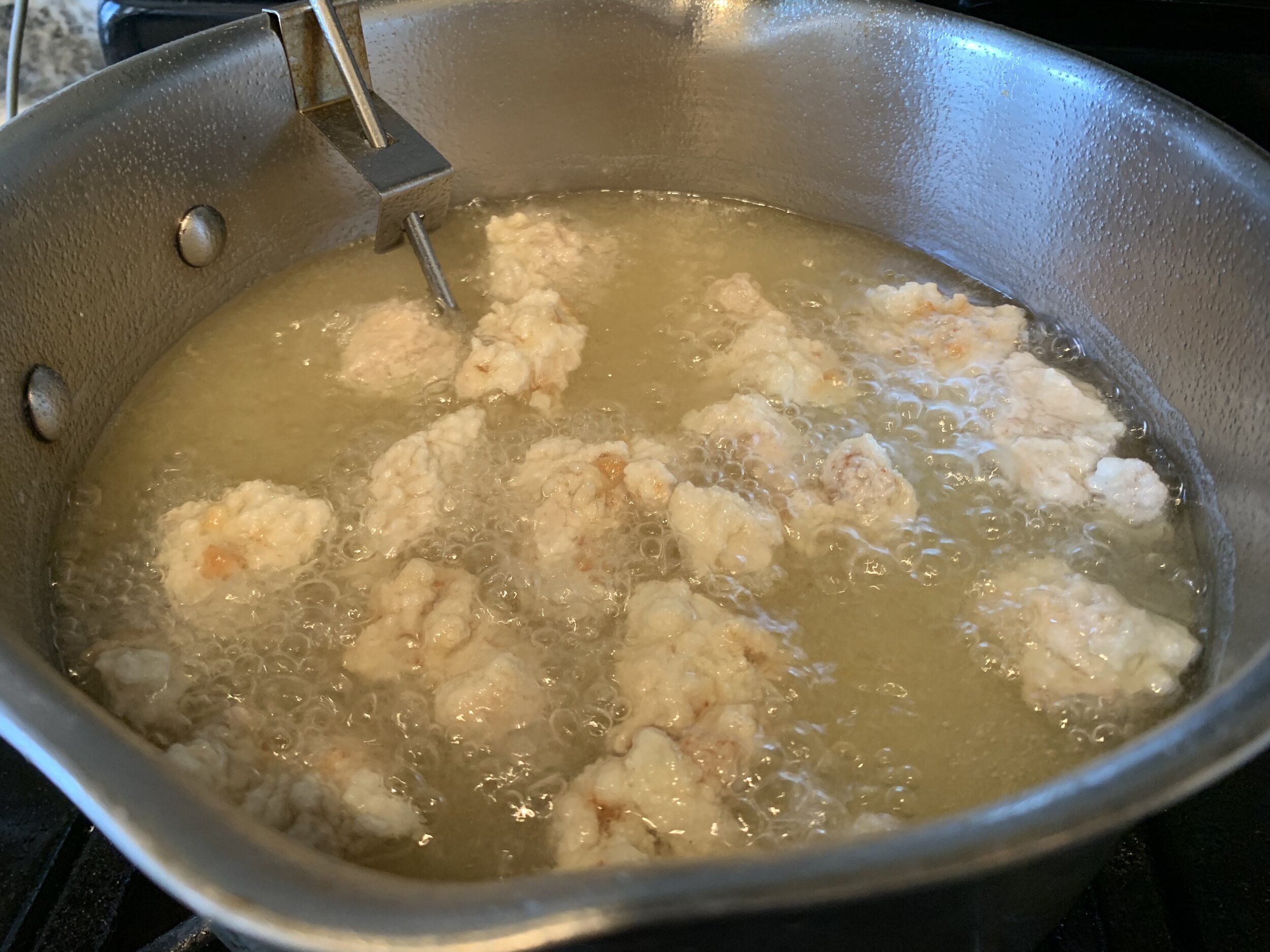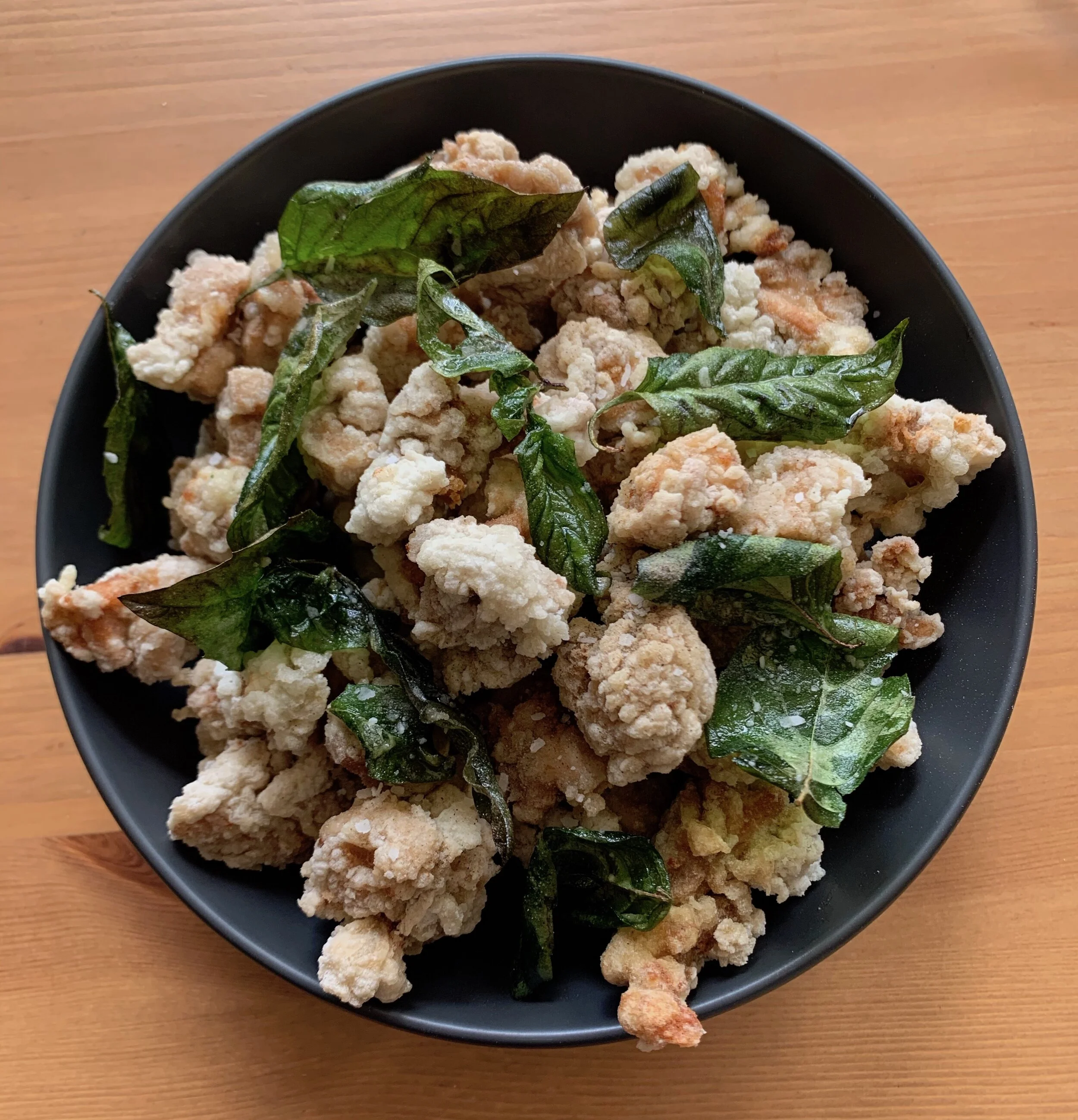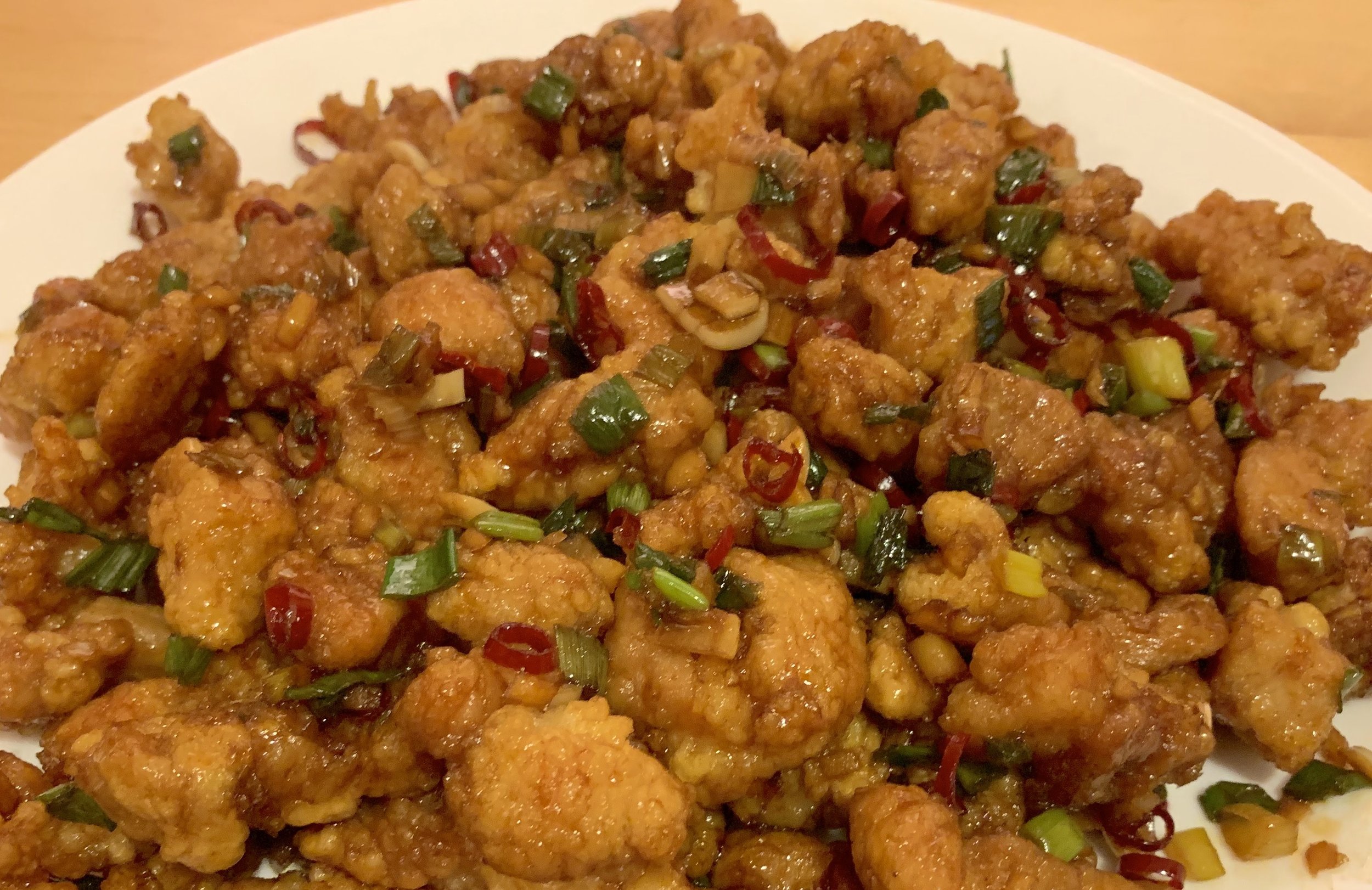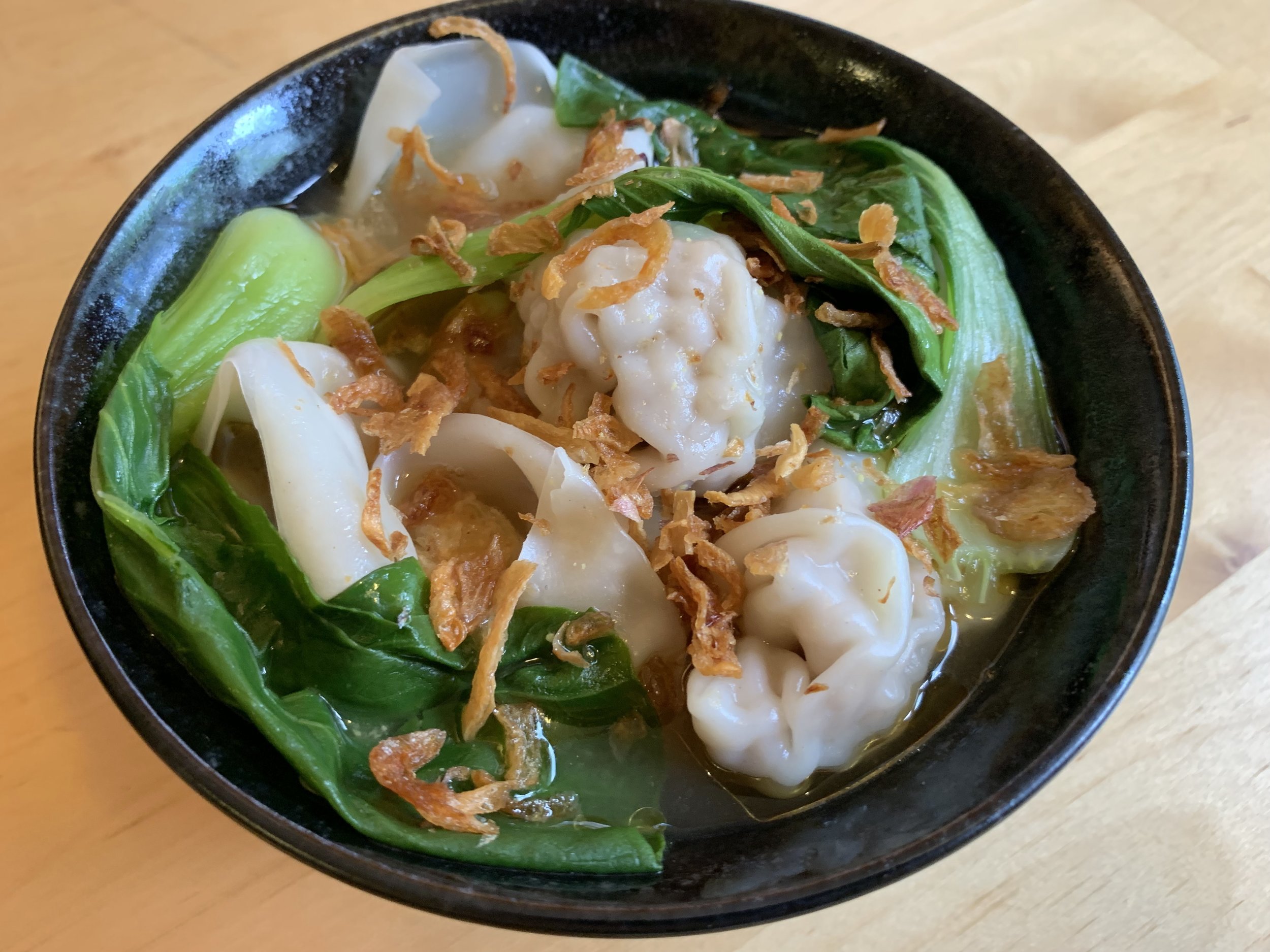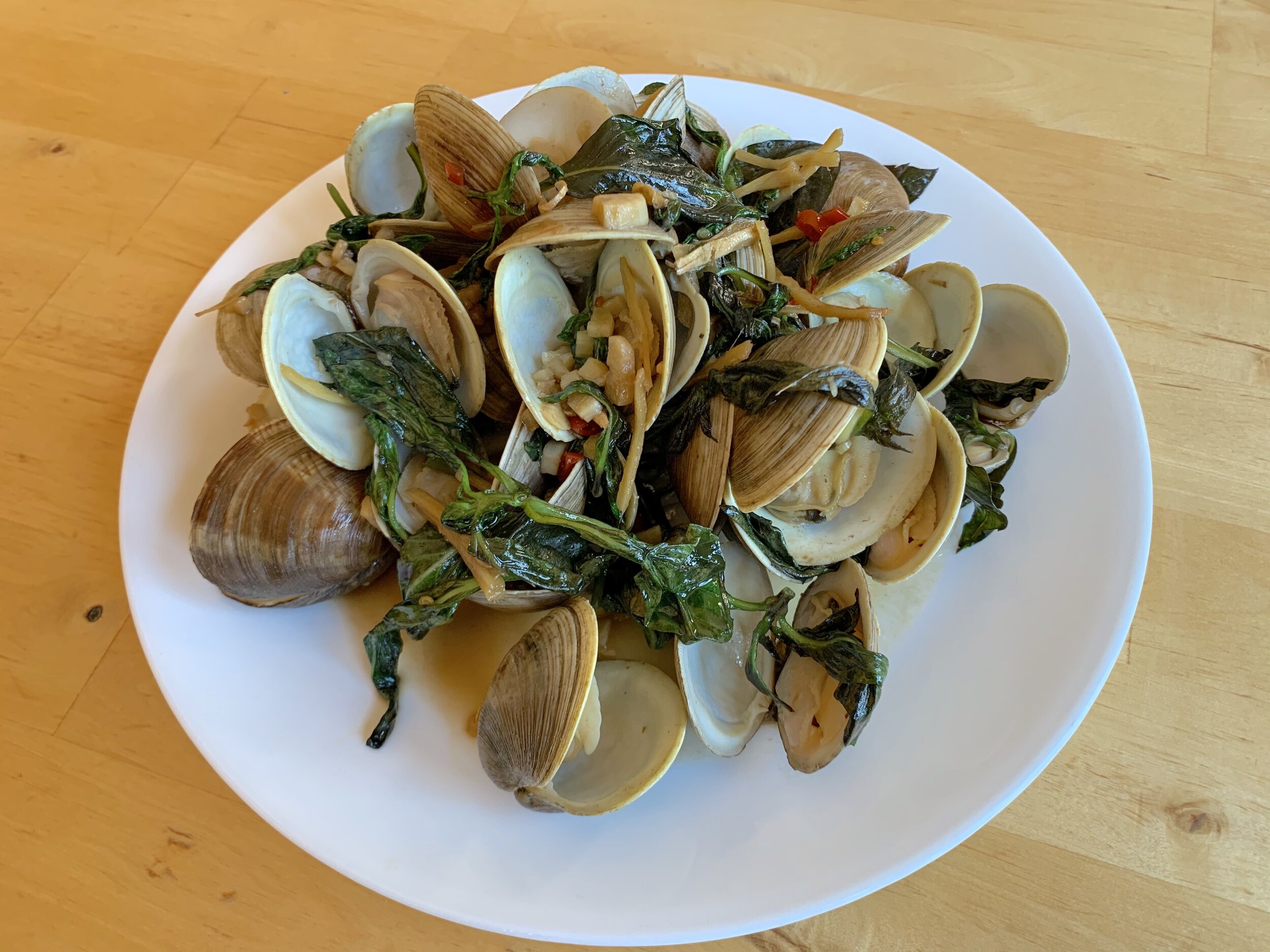Taiwanese Fried Chicken
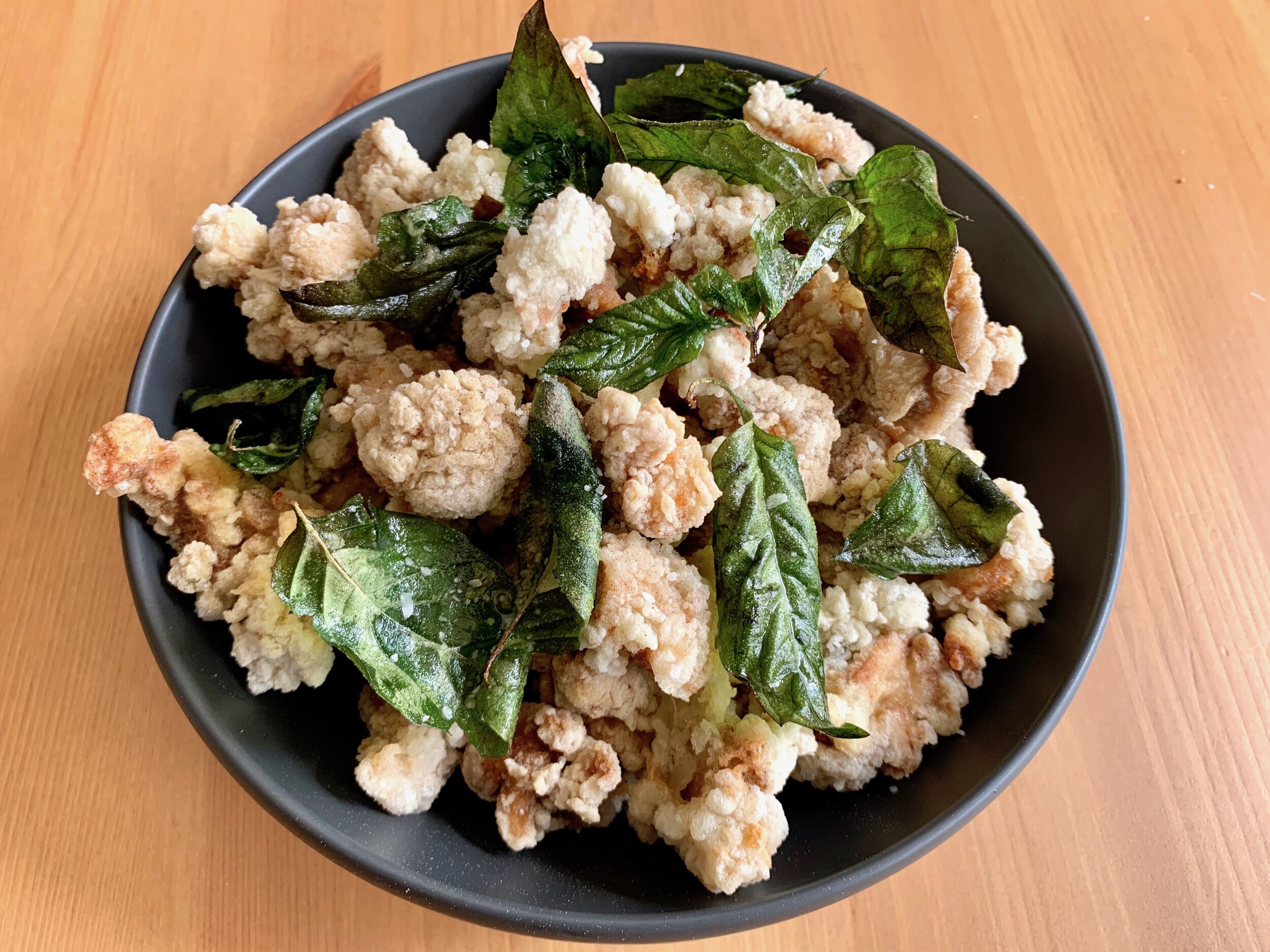
鹽酥雞 (Yan Su Ji)
Taiwanese fried chicken (鹽酥雞 or 鹹酥雞), sometimes westernized as “Taiwanese popcorn chicken,” is a wildly popular street snack in Taiwan. It was created in the city of Tainan in 1979, by street stall cooks adapting the concept of American-style southern fried chicken to local tastes.[1] It can now be found across the country, at food stalls, night markets, and pearl milk tea shops. Bite-size pieces of juicy chicken, breaded with a light, crispy coating and flavored with pepper and basil—what’s not to love? Here’s how to make it at home!
Ingredients
1 lb boneless chicken thighs
1 tbsp soy sauce
½ tsp five spice powder
1 tsp cornstarch
2 cloves garlic, minced
1 egg
1 cup sweet potato starch
1 bunch Thai basil (optional)
2 tsp flaky sea salt
2½ tsp white pepper
Vegetable oil
We will be using chicken thighs in this dish, as they are fattier than the white meat and thus cook up juicier and are less prone to drying out. Begin by cutting the chicken thighs into 1 inch cubes, trimming any excess fat. It is important that the chicken pieces are the same size, so they will cook in the same amount of time when fried.
Add the marinade ingredients to the chicken pieces: soy sauce, five spice powder, cornstarch, finely minced garlic, and ½ a teaspoon white pepper. The salt in the soy sauce will help the chicken retain moisture when cooked. Mix well, until the chicken is uniformly coated. Let marinade for at least 30 minutes, or in the refrigerator for 2 hours.
While the chicken marinates, prepare the Thai basil, if you are choosing to use it. We will be deep frying the Thai basil leaves, and we want them to be as dry as possible when they hit the hot oil—hot oil and water do not mix! Pick the Thai basil leaves, discarding the stems. Wash the leaves, then dry them thoroughly—first by getting as much water off the leaves with a salad spinner, and then laying them out to air dry for 30 minutes, with a paper towel to wick moisture.
We should also prepare our pepper salt, a simple combination of one part flaky sea salt to two parts ground white pepper. We want to be sprinkling it over freshly fried chicken while the chicken is still piping hot, when salt will adhere best, so it is a good idea to have a dish of it standing by.
When the chicken is ready to cook, prepare your breading station. In one bowl, beat together 1 egg with ½ a cup of water. The water thins out the egg, helping us achieve a lighter crust. In the second bowl, place 1 cup of sweet potato starch. Most Taiwanese fried foods are breaded in sweet potato starch, which creates a very light and crisp exterior, less dense than flour or cornstarch dredges. It’s also a good idea to prepare a landing zone upon which we can put our fried chicken—I prefer to use a cooling rack placed on a sheet pan, to allow excess oil to drip off the chicken. Line the sheet pan with paper towels to absorb this oil and simplify the cleanup.
A word about temperature control. A successful deep frying session should result in crispy food, but not greasy food. How is that possible? The physics of deep frying is still an area of active study,[2] but the basic principles are well understood. When food is deep fried, the water in the food turns to steam and tries to escape the food. The heated oil is full of high energy molecules as well, which will attempt to enter the food. As long as these two pressures are equal, the food will remain moist inside, with the steam pressure keeping the fry oil from penetrating beyond the outer coating. However, the amount of water in the food is finite, so only so much steam can be generated before the food is dry. This is how deep-fried foods get overcooked—they are submerged in hot oil at a given temperature for too long and literally run out of steam, drying out inside. Keep cooking after this, and oil will move in, giving you greasy food. To first order, this amount of time is a property of the food—based on its composition, density, moisture content, and geometry. It is not that dependent on oil temperature, since any hot oil will be above the boiling point of water.
So if that’s the case, why does the oil temperature matter? Well, keeping moisture in and oil out is not our only concern. We also have to ensure that our food gets properly cooked (for chicken, that means hitting an internal temperature of 165° F). The time this takes at a given temperature is proportional to the square of the radius, assuming the food is homogeneous,[3] but it is faster as a function of temperature. The name of the game when frying is to cook the food through before it runs out of steam. For relatively small foods, this means that you want to cook at a relatively high temperature, and cook quickly (for larger pieces of food, like a chicken leg, there is a third concern: ensuring that the center cooks before the edge overcooks. But that is a story for another day).
Maintaining the correct temperature when deep frying is always important, but it is particularly critical when frying delicately breaded foods, such as tempura. Taiwanese fried chicken falls into this category because of the airy nature of the crust formed by sweet potato starch. Because these coatings are so airy, they will absorb oil almost immediately if overcooked. To get the crisp, light texture we are looking for, we need to keep the oil temperature correct.
Part of maintaining the correct temperature is controlling the strength of the burner to maintain the temperature read out by the thermometer. However, adding (cold) food to the oil will also drop the temperature. We can minimize this drop in temperature by 1) using a heavy pot which retains heat, 2) using a large volume of oil, and 3) working in small batches.
With our lesson learned, let’s return to the recipe. Bring a couple inches of oil to 375° F in a heavy pot suitable for deep-frying. When the oil is up to temperature, begin breading and frying the chicken pieces. Working in small batches, dip the chicken pieces in the egg mixture, then dredge them in the sweet potato starch. Shake off the excess—you are looking for a very thin coat of starch. Immediately add the coated chicken pieces to the hot oil, and fry for 2-3 minutes until cooked. Remove the cooked chicken to the cooling rack, and sprinkle over some pepper salt to taste. Continue frying in small batches until all of the chicken is cooked.
When all of your chicken is done cooking, it is time to (optionally) fry the Thai basil. Frying herbs is a very neat trick, but before you start, triple check that the basil leaves are dry, unless you want an oil boil-over and kitchen fire on your hands! Then add the basil leaves to the oil. Fry for just 30 seconds, then remove to the cooling rack. Work in batches if necessary. The basil should now be intensely fragrant and shatteringly crisp, but still green.
Serve the fried chicken with the fried basil leaves, with a dish of pepper salt on the side for dipping. If you want the authentic night market experience, eat the chicken using toothpicks or small skewers!
Substitutions
You can substitute chicken breast for the chicken thigh in this recipe, but be vigilant about your fry times—breast is leaner and much more sensitive to overcooking. If you can’t find sweet potato starch, you can substitute cornstarch, but the results are really not the same. You can buy sweet potato starch in some Asian supermarkets (Korean markets in particular usually will stock it), or find it online. If you prefer a spicier snack, mix some cayenne or Sichuan pepper into your pepper salt.
[1] American-style fried chicken was one of several American foods which took root in Taiwan in the 60s and 70s (Another readily seen influence is the prevalence of ketchup in modern Taiwanese recipes). This influx of American food culture is often attributed to the heavy presence of United States Air Force personnel on the island during the Cold War.
[2] For more on the physics of deep frying and the nonlinear relationships between time, temperature, oil absorption, and moisture loss, refer to Fan et al., 2005, “The optimization of vacuum frying to dehydrate carrot chips,” and Manjunatha et al., 2014, “Kinetics of moisture loss and oil uptake during deep fat frying of Gethi strips.”
[3] Why is it proportional to r^2, not proportional to the volume ~r^3? I will leave this as an exercise for the reader.
Recipe
Prep Time: 15 min Cook Time: 15 min Total Time: 50 min
(+20 min inactive)
Difficulty: 3/5
Heat Sources: 1 burner
Equipment: pot for deep frying, thermometer, sheet pan, cooling rack
Servings: 6
Ingredients
1 lb boneless chicken thighs
1 tbsp soy sauce
½ tsp five spice powder
1 tsp cornstarch
2 cloves garlic, minced
1 egg
1 cup sweet potato starch
1 bunch Thai basil (optional)
2 tsp flaky sea salt
2½ tsp white pepper
Vegetable oil
Instructions
1. Cut the chicken thighs into 1 inch cubes and place in a mixing bowl. Add the soy sauce, five spice powder, cornstarch, minced garlic, and ½ tsp white pepper, and mix well. Let marinade for 30 minutes.
2. Pick the Thai basil leaves, wash them, and then dry them thoroughly (use a salad spinner, then lay out to air dry).
3. Mix together 2 tsp white pepper and 1 tsp flaky sea salt, and set the pepper salt aside.
4. When the chicken is ready to cook, prepare your breading station. In one bowl, beat together 1 egg and ½ cup water. In a second bowl, place the sweet potato starch. Prepare a holding area for cooked chicken by placing a cooling rack on a sheet tray.
5. Bring a couple inches of oil to 375° F in a heavy pot suitable for deep-frying. When the oil is hot, begin breading and frying the chicken pieces. Working in small batches, dip the chicken pieces in the egg mixture, then dredge them in the sweet potato starch, shaking off the excess.
6. Place the coated chicken pieces in the hot oil and cook for 2-3 minutes, or until crisp and cooked through. Remove the cooked chicken to the cooling rack, and sprinkle with pepper salt (to taste) while still hot.
7. Work in small batches until all of the chicken is cooked.
8. (Optional) Add the dry Thai basil leaves to the oil and fry for 30 seconds, or until the basil leaves are just crisp. Immediately remove from the oil and place on the cooling rack.
9. Serve the chicken with the fried basil, and extra pepper salt on the side for dipping.











